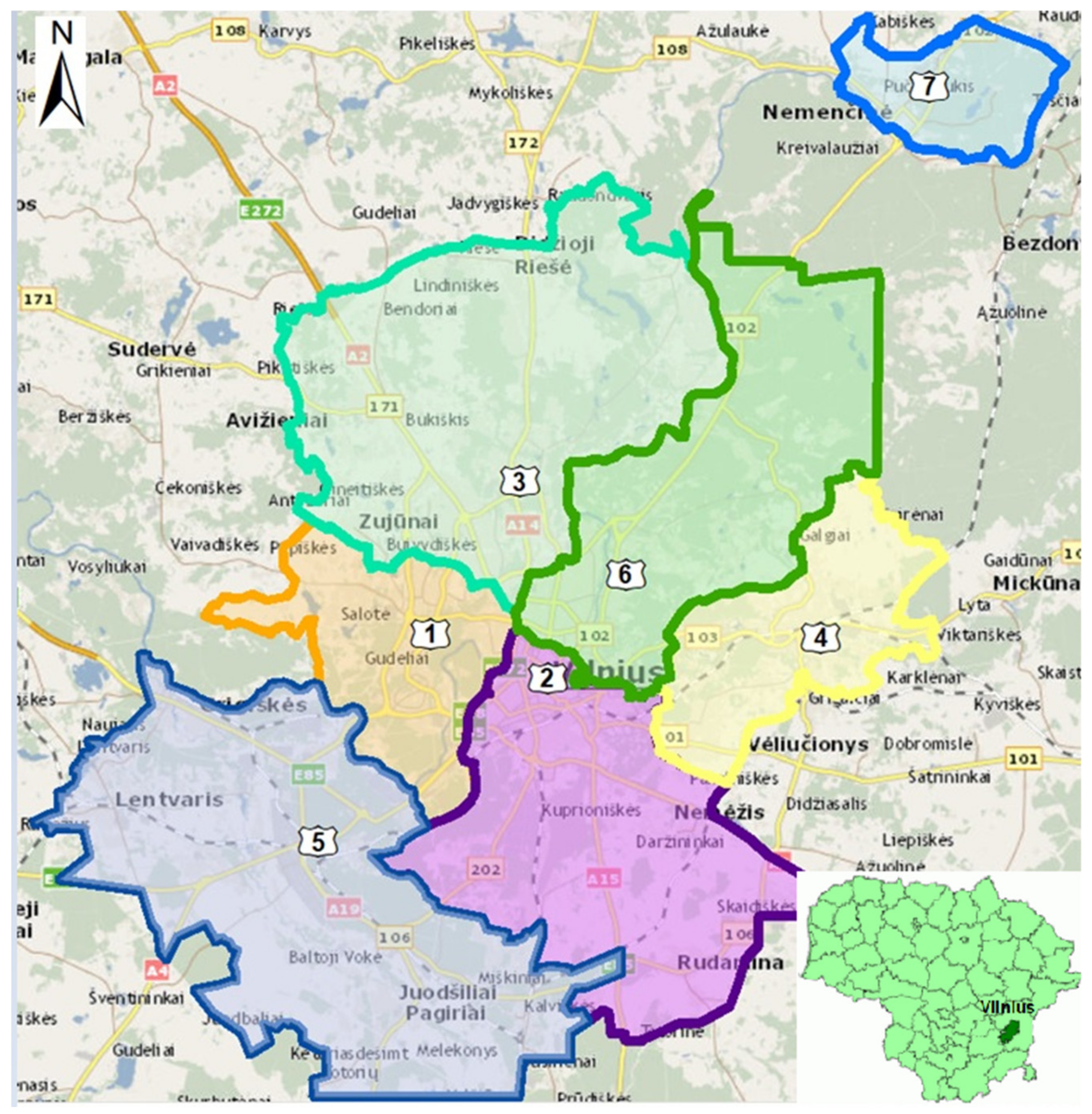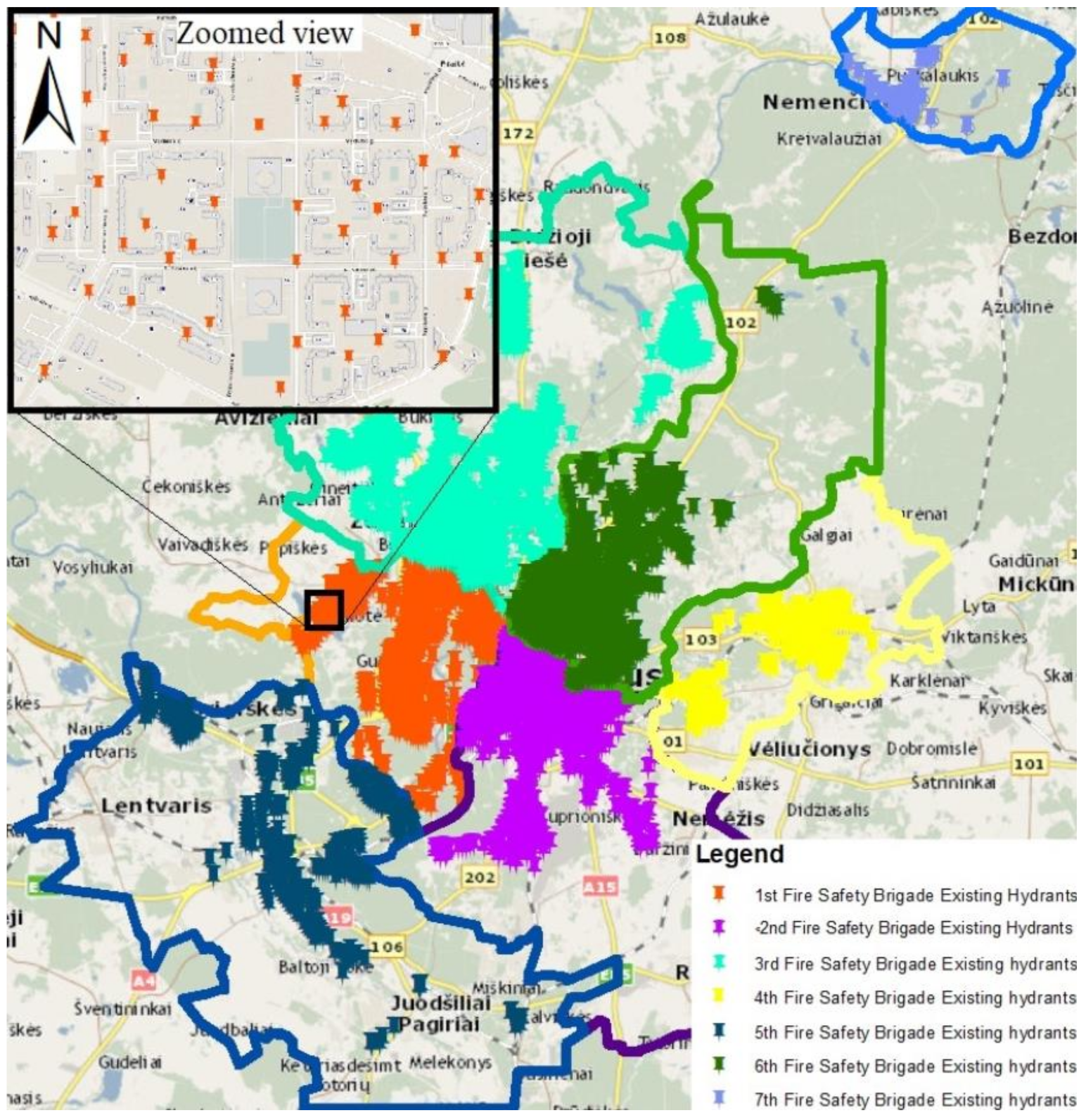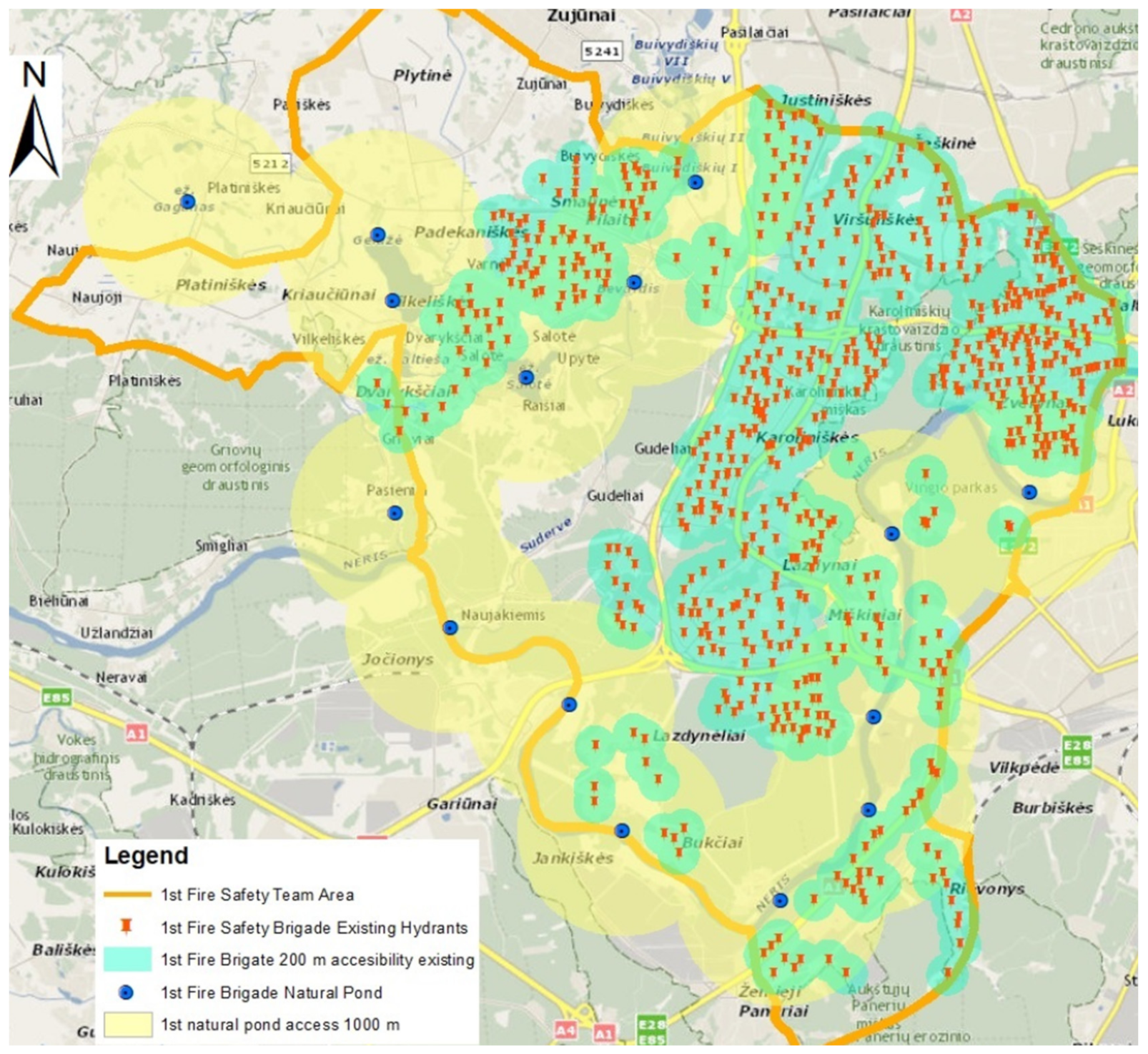An Approach for the Analysis of the Accessibility of Fire Hydrants in Urban Territories
Abstract
:1. Introduction
- Fire prevention: the most cost-effective and efficient mitigation program an agency or community can implement. Preventing unwanted, damaging fires is always less costly than suppressing them. Prevention programs that are accepted and promoted within the community not only reduce costs and resource damage, but also promote an understanding of the role and impact of fire in the ecosystem;
- Fire preparedness: includes training, equipping and staffing prior to the start of a fire. An effective fire preparedness program should be based on ‘fire risk and resource management’ planning, and should take into account year-to-year variations in funding, weather and human activities.
2. Analysis of Innovative Fire Risk Management Practice in EU Countries
3. Materials and Methods
4. The Outline of the Experiment
4.1. Step 1: Collection and Preparation of Information
4.2. Step 2: Territorial Spatial Analysis
4.3. Step 3: Determination of Unprotected Buildings
4.4. Step 4: Analysis and Evaluation
5. Results of the Experiment and Discussion of the Approach
6. Conclusions and Recommendations
- Review of fire risk management practice in EU countries and Lithuania exposed that following the best European experience from Germany and Austria, it is essential to prepare an accessible day-to-day database for responsible organizations and outside public utilities by using tools for maximizing the fire risk preparedness.
- A geographic information system is a powerful tool to achieve fire risk management missions, so as to enhance situational awareness, improve a fire fighter’s safety, access real-time fire data, and control efforts, as well as develop existing strategies, optimize resource placement, and also develop a budget, support incident management mapping and evaluation. These missions are succeeded with GIS by creating hydrants and fire brigade’s infrastructure maps, analysing response zones, pre-planning and managing responsible inspections, etc. Based on GIS methodology, implementation of GIS technologies for fire and rescue control highly depends on proper project planning and management.
- The article presents a four-step approach comprising collection and preparation of data, territorial spatial analysis, determination of unprotected buildings, analysis and evaluation. Moreover, this case study reveals qualitative and quantitative aspects in research on the accessibility of fire hydrants. While comprehensiveness may be desirable in the analysis of urban infrastructures, this article presents a qualitative approach that could be easily replicated in other cities where GIS-based fire risk management systems under consideration or in the early development phase. The experiment in this case study might be interesting in the sense that it has been applied to a real city and leads to a systematization of the need for quantitative data.
- During the experiment, the Vilnius municipal hydrants system was developed and a database of seven fire brigades operating in separate Vilnius town parts was created. This experiment was based on a GIS database, and an analysis of the accessibility of 4517 fire hydrants and 280 natural water ponds points in Vilnius were performed. Spatial experimental methods (clip, split, select, spatial join, buffer tools, etc.) were applied to determine problematic zones without access to fire hydrants. Fire hydrant access point (200 m) and natural water ponds (1000 m) buffers were applied to measure the building’s reachability. As a result, 3027 buildings’ polygons were identified without any water extinguishing possibility. The most important ‘Unprotected area’ layer as a polygon was created with a 49,307.17 ha area, and it is 13.51% of the Vilnius Fire Brigade’s operation area. The further comparative analysis reveals that the primary priority task is to formulate the appropriate technical accessibility and capacity of the fire hydrants, as Lithuanian instructions and rules indicate, and only the secondary task is to consider the density of the population or buildings area.
- After visualization of the accessibility of municipal fire hydrants in Vilnius city, it was observed that there are 735 thousand m2 of unprotected building’s area (or 3027 units). These experimental results require further experimental analysis with more data (private extinguishing system, underground water lines, etc.).
- As a follow-up to the findings of this research, the following recommendations are suggested for improving the fire risk management in Lithuania:
- The Fire and Rescue Department must integrate GIS as software for fire risk management. The accessibility of the fire hydrants experiment with GIS was a significant example that information systems could be a useful tool for saving time and making investigations of identifying unprotected buildings.
- Theoretically identified unprotected areas could be solved by providing new hydrants’ installation, but the determination of hydrant access points requires more specific data and information (private extinguishing systems, municipal water networks, Vilnius development plan, etc.). It is recommended to employ not only existing information, but the future Vilnius development plan for future research.
- To avoid additional costs and save expenses for future fire hydrants’ installation, it is important to create a complex GIS system that could be implemented with other department’s data and could help to eliminate mistakes and failures.
- Learning from EU countries’ experience, it is recommended to develop fire risk management, not only on legal and institutional policies, but also on organizations, agencies and communities which shall also be involved in the sustainable development of fire safety.
Author Contributions
Funding
Acknowledgments
Conflicts of Interest
References
- United Nations. Sustainable Development Goals. Available online: https://www.un.org/sustainabledevelopment/sustainable-development-goals/ (accessed on 9 May 2019).
- Martin, D.A. Linking fire and the United Nation Sustainable Development Goals. Sci. Total Environ. J. 2018, 662, 547–558. [Google Scholar] [CrossRef] [PubMed]
- International Association of Fire and Rescue Services. World Fire Statistics 2005–2017, World Fire Statistics Magazine No. 22. 2017. Available online: https://www.ctif.org/world-fire-statistics (accessed on 15 May 2019).
- Brushlinsky, N.N.; Ahrens, M.; Sokolov, S.V.; Wagner, P. CTIF World Fire Statistics 2019, No. 24; CTIF Center of Fire Statistics: Berlin, Germany, 2019. [Google Scholar]
- Zhang, H.; Cheng, C.; Miao, S. A Precise Urban Component Management Method Based on the GeoSOT Grid Code and BIM. ISPRS Int. J. Geo-Inf. 2019, 8, 159. [Google Scholar] [CrossRef] [Green Version]
- Malienė, V.; Grigonis, V.; Palevičius, V.; Griffiths, S. Geographic Information System: Old Principles with New Capabilities. Urban Design International; Macmillan Publishers Ltd.: New York, NY, USA, 2011; pp. 1–6. [Google Scholar] [CrossRef]
- World Health Organization. Burn Prevention, Success Stories Lessons Learned; World Health Organization: Geneva, Switzerland, 2011. [Google Scholar]
- Jennings, C.R. Social and economic characteristics as determinants of residential fire risk in urban neighborhoods: A review of the literature. Fire Saf. J. 2013, 62, 13–19. [Google Scholar] [CrossRef]
- Xia, Z.; Li, H.; Chen, Y.; Yu, W. Detecting urban fire high-risk regions using colocation pattern measures. Sustain. Cities Soc. 2019, 49, 101607. [Google Scholar] [CrossRef]
- Zhang, X.; Yao, J.; Sila-Nowicka, K. Exploring Spatiotemporal Dynamics of Urban Fires: A Case of Nanjing, China. ISPRS Int. J. Geo-Inf. 2018, 7, 7. [Google Scholar] [CrossRef] [Green Version]
- FAO. Fire Management: Voluntary Guidelines. Principles and Strategic Actions. Fire Management Working Paper 17. Rome. 2006. Available online: http://www.fao.org/3/j9255e/j9255e00.pdf (accessed on 10 May 2019).
- Enrica Verrucci, E.; Perez-Fuentes, G.; Rossetto, T.; Bisby, L.; Haklay, M.; Rush, D.; Rickles, P.; Fagg, G.; Joffe, H. Digital engagement methods for earthquake and fire preparedness: A review. Nat. Hazards 2016, 83, 1583. [Google Scholar] [CrossRef] [Green Version]
- Barbosa, P.; Kucera, J.; Strobl, P. European Forest Fire Information System (EFFIS)-Rapid Damage Assessment: Appraisal of burnt area maps with MODIS data. In Proceedings of the 6th International Workshop of The EARSeL Special Interest Group On Forest Fires—Advances in Remote Sensing and GIS Applications in Forest Fire Management: Towards An Operational Use of Remote Sensing in Forest Fire Management, 27–29 September 2007, Thessaloniki, Greece; Institute for Environment and Sustainability: Ispra, Italy, 2007; ISSN 1018-5593. [Google Scholar]
- Nisanci, R. GIS based fire analysis and production of fire-risk maps: The Trabzon experience. Sci. Res. Essays 2010, 5, 970–977. [Google Scholar]
- Xia, Z.; Li, H.; Chen, Y. An Integrated Spatial Clustering Analysis Method for Identifying Urban Fire Risk Locations in a Network-Constrained Environment: A Case Study in Nanjing, China. ISPRS Int. J. Geo-Inf. 2017, 6, 370. [Google Scholar] [CrossRef]
- Edwards, J.; Koval, E.; Lendt, B.; Ginther, P. GIS and hydraulic model integration: Implementing cost-effective sustainable modelling solutions. J. AWWA 2009, 101, 34–42. [Google Scholar] [CrossRef]
- Conant, J.B.; Lewis, D. Improve fire hydrant assessments with GIS. J. AWWA 2014, 40, 24. [Google Scholar]
- Xia, Z.; Li, H.; Chen, Y.; Yu, W. Integrating Spatial and Non-Spatial Dimensions to Measure Urban Fire Service Access. ISPRS Int. J. Geo-Inf. 2019, 8, 138. [Google Scholar] [CrossRef] [Green Version]
- Wielebski, Ł.; Medyńska-Gulij, B. Cartographic visualization of fire hydrants accessibility for the purpose of decision making. Geodesy Cartogr. 2013, 62, 183–198. [Google Scholar] [CrossRef] [Green Version]
- Lithuanian Republic Law of Fire Safety. Available online: https://e-seimas.lrs.lt/portal/legalAct/lt/TAD/TAIS.197461/asr (accessed on 27 November 2019). (In Lithuanian).
- General Fire Safety Instructions. Available online: https://e-seimas.lrs.lt/portal/legalAct/lt/TAD/TAIS.250714/asr (accessed on 27 November 2019). (In Lithuanian).
- Fire and Rescue Department under the Ministry of Internal Affairs, Rules for the Design and Installation of Outdoor Fire Water Supply Networks and Structures. Available online: https://pagd.lrv.lt/lt/veiklos-sritys-1/valstybine-priesgaisrine-prieziura/statiniu-projektavimo-taisykles (accessed on 15 May 2019).
- Federation of European Union Fire Officer Associations. Pan European Fire Safety Strategy 2020; Chief Fire Officers Association: Birmingham, UK, 2012. [Google Scholar]
- Federation of the European Union. Fire Officers Associations: Legislation in Austria. Available online: https://www.f-e-u.org/national_legi.php (accessed on 28 November 2019).
- Vienna Town Council. Public Infrastructure Manual Vienna; Vienna Town Council: Vienna, Austria, 2018.
- Open Government Wien: Datenaftritt -Stadt Wien. Available online: https://www.data.gv.at/auftritte/?organisation=stadt-wien (accessed on 28 November 2019).
- Austrian Open Government Data Basemap. 2016. Available online: https://www.basemap.at/index_en.html (accessed on 28 November 2019).
- The Confederation of Fire Protection Associations Europe: Legislation in Germany. Available online: http://cfpa-e.eu/national-regulations/regulations-germany/ (accessed on 28 November 2019).
- Germany’s Leading Independent Testing Institution for Fire Protection and Security. 2011. Available online: http://vds-global.com/en/about-vds/ (accessed on 28 November 2019).
- Remote Sensing for Water Resource Mapping. 2019. Available online: http://uizentrum.de/en/remote-sensing-services-2/water-resource-mapping/ (accessed on 28 November 2019).
- Hydrant Maintenance Inspection: Overview. 2019. Available online: https://solutions.arcgis.com/utilities/water/help/hydrant-maintenance-inspection (accessed on 28 November 2019).
- European Commission. The European Forest Fire Information System. Available online: http://effis.jrc.ec.europa.eu/ (accessed on 12 May 2019).
- ESRI White Paper; GIS for the Fire Service. 2012. Available online: https://www.esri.com/library/whitepapers/pdfs/gis-for-fire-service.pdf (accessed on 28 November 2019).
- Kaufman, M.M.; Rosencrants, T. GIS method for characterizing fire flow capacity. Fire Saf. J. 2015, 72, 25–32. [Google Scholar] [CrossRef]
- Liu, S.J.; Zhu, G.Q. The application of GIS and IOT technology on building fire evacuation. Procedia Eng. 2014, 71, 577–582. [Google Scholar] [CrossRef] [Green Version]
- Xiong, Q.; Zhu, Q.; Du, Z.; Zhu, X.; Zhang, Y.; Niu, L.; Li, Y.; Zhou, Y. A Dynamic Indoor Field Model for Emergency Evacuation Simulation. ISPRS Int. J. Geo-Inf. 2017, 6, 104. [Google Scholar] [CrossRef]
- The Department of Statistics. Population and Social Statistics. 2018. Available online: https://osp.stat.gov.lt/ (accessed on 7 February 2019).
- Češljar, G.; Stevović, S. Small reservoirs and their sustainable role in fires protection of forest resources. Renew. Sustain. Energy Rev. 2015, 47, 496–503. [Google Scholar] [CrossRef]
- Vasiliauskas, D.; Beconytė, G. Spatial analysis of fires in Vilnius city in 2010–2012. Geodesy Cartogr. 2015, 41, 25–30. [Google Scholar] [CrossRef] [Green Version]
- Hamdy, O.; Zhao, S.; Salheen, M.A.; Eid, Y.Y. Identifying the risk areas and urban growth by ArcGIS-tools. Geosciences (Switzerland) 2016, 6, 47. [Google Scholar] [CrossRef] [Green Version]






| Fire Brigade | Address | Operation Area, ha | Number of Fire Hydrants Access Points | Number of Natural Water Ponds |
|---|---|---|---|---|
| 1 | R. Jankausko g. 2, Vilnius | 4736.97 | 660 | 15 |
| 2 | Švitrigailos g. 18, Vilnius (with Fire and Rescue Department) | 9829.29 | 1073 | 56 |
| 3 | Ateities g. 17, Vilnius | 12,772.16 | 1127 | 78 |
| 4 | Pergalės g. 31, Vilnius | 4669.63 | 268 | 31 |
| 5 | Kirtimų g. 37, Vilnius | 13,644.19 | 367 | 52 |
| 6 | P. Vileišio g. 20A, Vilnius | 9026.50 | 974 | 29 |
| 7 | Švenčionių g. 64A, Nemenčinė | 2335.87 | 48 | 19 |
| Total: | 57,014.61 | 4517 | 280 | |
| Vilnius District | District Area, ha | Quantity of Unprotected Buildings | Area of Unprotected Buildings, m2 | Percentage of Total Unprotected Building’s Area, % |
|---|---|---|---|---|
| Area of Fire Brigade 1 | ||||
| Ž. Paneriai | 740.7 | 3 | 23,324.75 | 19.27 |
| Karoliniškės | 398 | 6 | 841.18 | 0.70 |
| Salotė | 485.1 | 111 | 15,314.22 | 12.65 |
| Pilaitė I | 493.6 | 24 | 2227.54 | 1.84 |
| Pilaitė II | 370.9 | 182 | 32,558.49 | 26.90 |
| Viršuliškės | 267.7 | 5 | 625.25 | 0.52 |
| Medžiakalnis | 630.2 | 325 | 46,140.08 | 38.12 |
| Total: | 656 | 12,1031.55 | 100 | |
| Area of Fire Brigade 2 | ||||
| Naujininkai | 311.4 | 33 | 16,420.53 | 15.28 |
| Ž. Paneriai | 740.7 | 3 | 2928.04 | 2.72 |
| Kirtimai | 1477.6 | 167 | 78,035.37 | 72.62 |
| Nemėžis | 3473.5 | 54 | 10,072.75 | 9.37 |
| Total: | 257 | 107,456.70 | 100 | |
| Area of Fire Brigade 3 | ||||
| Verkiai | 3123.0 | 24 | 3947.64 | 2.66 |
| Riešė | 7439.0 | 69 | 11,596.37 | 7.83 |
| Santariškės | 2010.0 | 447 | 65,209.42 | 44.0 |
| Avižieniai | 4660.0 | 105 | 17,675.66 | 11.93 |
| Fabijoniškės | 369.0 | 12 | 7083.24 | 4.78 |
| Baltupiai | 431.7 | 9 | 13,213.08 | 8.92 |
| Pašilaičiai | 330.1 | 183 | 23,323.42 | 15.74 |
| Total: | 849 | 148,191.93 | 100 | |
| Area of Fire Brigade 4 | ||||
| N. Vilnia | 2369.4 | 49 | 6479.90 | 36.16 |
| Pavilnys | 1552.4 | 82 | 11,438.14 | 63.84 |
| Total: | 131 | 17,918.04 | 100 | |
| Area of Fire Brigade 5 | ||||
| Gariūnai | 2026.2 | 156 | 98,733.94 | 35.21 |
| Ž. Paneriai | 740.7 | 18 | 2021.14 | 0.72 |
| Lentvaris | 1045.5 | 91 | 38,085.97 | 13.58 |
| Trakų Vokė | 2063.0 | 222 | 71,506.89 | 25.50 |
| A. Paneriai | 2393.0 | 318 | 67,696.51 | 24.14 |
| Vaidotai | 1195.8 | 38 | 2368.38 | 0.84 |
| Total: | 843 | 280,450.24 | 100 | |
| Area of Fire Brigade 6 | ||||
| Valakupiai | 5348.3 | 25 | 3979.30 | 6.67 |
| Dvarčionys | 1550.9 | 99 | 12,569.22 | 21.05 |
| Antakalnis | 837.3 | 87 | 12,696.75 | 21.27 |
| Belmontas | 531.4 | 80 | 30,456.19 | 51.01 |
| Total: | 291 | 59,701.46 | 100 | |
© 2019 by the authors. Licensee MDPI, Basel, Switzerland. This article is an open access article distributed under the terms and conditions of the Creative Commons Attribution (CC BY) license (http://creativecommons.org/licenses/by/4.0/).
Share and Cite
Raškauskaitė, R.; Grigonis, V. An Approach for the Analysis of the Accessibility of Fire Hydrants in Urban Territories. ISPRS Int. J. Geo-Inf. 2019, 8, 587. https://0-doi-org.brum.beds.ac.uk/10.3390/ijgi8120587
Raškauskaitė R, Grigonis V. An Approach for the Analysis of the Accessibility of Fire Hydrants in Urban Territories. ISPRS International Journal of Geo-Information. 2019; 8(12):587. https://0-doi-org.brum.beds.ac.uk/10.3390/ijgi8120587
Chicago/Turabian StyleRaškauskaitė, Raminta, and Vytautas Grigonis. 2019. "An Approach for the Analysis of the Accessibility of Fire Hydrants in Urban Territories" ISPRS International Journal of Geo-Information 8, no. 12: 587. https://0-doi-org.brum.beds.ac.uk/10.3390/ijgi8120587





